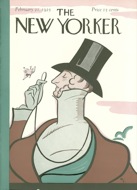|
My New Yorker arrives on Thursday.
It used to arrive on Monday. The only difference, as far as I can tell, is that the United States Postal Service has stopped trying. Paranoid that I am, I suspect a plot. I used to have a ritual. Very early in the week, Monday if possible, I would sit down with the New Yorker, at the expense of other reading material. I would scan it for concerts, art exhibits, odd lectures, take a peek at the fiction, look for the article I never could have imagined. The week was young. But now I don’t get the New Yorker until Thursday, and some events have already taken place. I ascertained that the New Yorker had not changed its publishing or mailing routine. Then I went to the local post office and got a civil answer from a civil servant. Turns out, to save money, the Postal Service now routes magazines and other stuff through another post office 15 miles away. That would account for a day’s lateness, the friendly person said. I count three days. If the Postal Service cannot deliver somewhat perishable reading material in reasonable time, it can also be willfully late in delivering medication, checks, or that relic from the prehistoric age, the letter. Printed matter is already in trouble, as proven by the changes in publishing and journalism. I believe some people will be willing to pay for books and newspapers in their hands – but what about magazines that arrive three days late? I know, I know, the New Yorker is on line. That’s how I found a lovely essay by my friend Roger Angell on Jan. 2, about the decline of the old-fashioned letter. (Roger practices what he preaches; he sent me a sweet letter recently. His handwriting is better than mine.) The essay was classic Angell, witty and crisp and knowing. I’m all for interactive searching of the web to find treasures like this. But when you trust editors to present you material you were not expecting, as I trust the people who produce The New York Times and the New Yorker, it’s worth committing time and money to hold that miracle in your hands. Here’s what I think is happening: people have bellowed so much about getting government out of their lives that it is becoming a self-fulfilling prophecy. This is why Amtrak is so wretched -- because a portion of the country hates the thought of crack trains flitting through Europe and Japan. That’s not the rugged individualist way. Part of the United States has started to doubt the reason for collective behavior. What better place to withdraw commitment than the Postal Service? It’s a plot, I’m telling you. Now I am sitting down with the New Yorker. Gotta catch up.
Hansen Alexander
2/2/2012 01:46:30 pm
Although my wife notes that we do get the New Yorker on Mondays, we do live in Manhattan. However, many packages not requiring signatures are not left, and getting them redelivered is certainly more complicated than the air routes negotiated by Hap Arnold and the Army Air Force during World War II above Asia. It is hard to find a Manhattan post office where the employees are not mad as hell and bent on not taking it anymore. You're not paranoid George. The Post Office was once our friend. The mail career brought a cheerful smile and your social security check in hand if you were retired. The Postal Service was the human form of the Government, the assurance that the developing West was part of the United States and that leaders in Washington cared about settlers in Idaho. The greatest gift, George, was a letter from your parents or your aunts or your friends, and it has remained a cheap bargain even as the price of stamps went from a penny to two pennies to several pennies to almost half a dollar now. But we're infatuated with saving money at the expense of service, of human feelings. With less government service such as the Post Office, we are not headed toward limited government. We are headed toward anarchy and decline. That's not being paranoid. That's reading history.
Dave Tainer
2/4/2012 04:27:26 pm
No matter how much I tried, I, like you, always tried to read the New Yorker "happening" section on Monday, to plan shows and events: never really worked. More often than not, I didn't read until Saturday, and then I had missed just about everything. I'd call out to The Wife some show that she would have wanted to go, and the obligatory "sorry, just read this now". 4/12/2016 03:39:08 am
The best part of this blog is strategic planning. You have to ready for the bad days. Comments are closed.
|
Categories
All
|










